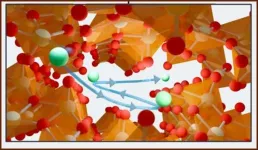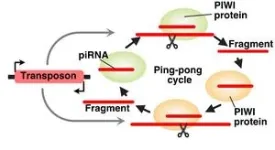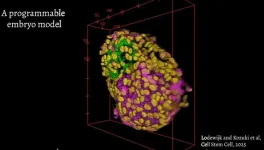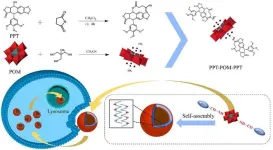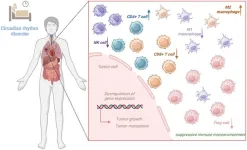(Press-News.org) Lithium-6 is essential for producing nuclear fusion fuel, but isolating it from the much more common isotope, lithium-7, usually requires liquid mercury, which is extremely toxic. Now, researchers have developed a mercury-free method to isolate lithium-6 that is as effective as the conventional method. The new method is presented March 20 in the Cell Press journal Chem.
“This is a step towards addressing a major roadblock to nuclear energy,” says chemist and senior author Sarbajit Banerjee of ETH Zürich and Texas A&M University. “Lithium-6 is a critical material for the renaissance of nuclear energy, and this method could represent a viable approach to isotope separation.”
The conventional method used to isolate lithium-6, called the COLEX process, involves liquid mercury and has been banned in the United States since 1963 due to pollution concerns. Since then, almost all lithium-6 used in US research has relied on a diminishing stockpile maintained at Oak Ridge National Laboratory in Tennessee. Having a safe method of isolating lithium-6 will be key to unlocking nuclear fusion as a sustainable energy source.
The researchers stumbled upon their method of isolating lithium-6 isolation while developing membranes for cleaning “produced water” — groundwater that is brought to the surface during oil and gas drilling and that must be cleaned before it can be pumped back underground. They noticed that their cleaning membrane captured disproportionate quantities of lithium in the water.
“We saw that we could extract lithium quite selectively given that there was a lot more salt than lithium present in the water,” says Banerjee. “That led us to wonder whether this material might also have some selectivity for the 6-lithium isotope.”
The membrane’s lithium-binding properties are due to a material called zeta-vanadium oxide (ζ-V2O5), a lab-synthesized inorganic compound that contains a framework of tunnels running in a single dimension.
“Zeta-V2O5 has some pretty incredible properties—it's an amazing battery material, and now we're finding that it can trap lithium very selectively, even with isotopic selectivity,” says Banerjee.
To test whether the material could separate lithium-6 from lithium-7, the team set up an electrochemical cell with a zeta-V2O5 cathode. When they pumped an aqueous solution containing lithium ions through the cell while applying a voltage, the positively charged lithium ions were drawn towards the negatively charged zeta-V2O5 matrix and into its tunnels. Because lithium-6 and lithium-7 ions move differently, the zeta-V2O5 tunnels preferentially captured lithium-6 ions while the more mobile lithium-7 ions escaped capture.
“Lithium-6 ions stick a lot stronger to the tunnels, which is the mechanism of selectivity,” says co-first author Andrew Ezazi of Texas A&M. “If you think of the bonds between V2O5 and lithium as a spring, you can imagine that lithium-7 is heavier and more likely to break that bond, whereas lithium-6, because it's lighter, reverberates less and makes a tighter bond.”
As lithium ions are integrated into the zeta-V2O5, the compound gradually changes color from bright yellow to dark olive green, which enables the degree of lithium isolation to be easily monitored.
The team shows that a single electrochemical cycle enriched lithium-6 by 5.7%. To obtain fusion-grade lithium, which requires a minimum of 30% lithium-6, the process needs to be repeated 25 times, and 90% lithium-6 can be obtained in about 45 sequential cycles.
“This level of enrichment is very competitive with the COLEX process, without the mercury,” says Ezazi.
“Of course, we're not doing industrial production yet, and there are some engineering problems to overcome in terms of how to design the flow loop, but within a bunch of flow cycles, you can get fusion-grade lithium for quite cheap,” says Banerjee.
The researchers say that their results suggest that materials like zeta-V2O5 could be used to isolate other substances, for example, to separate radioactive from non-radioactive isotopes.
Now, the team is taking steps to scale their method up to an industrial level.
“I think there's a lot of interest in nuclear fusion as the ultimate solution for clean energy,” says Banerjee. “We're hoping to get some support to build this into a practicable solution.”
###
This research was supported by the National Science Foundation, Texas A&M, the Canada Foundation for Innovation, the Natural Sciences and Engineering Research Council of Canada, the Canadian Institutes of Health Research, the National Research Council Canada, the Canadian Institutes of Health Research, the Government of Saskatchewan, the University of Saskatchewan, and the Qatar Research, Development and Innovation Council.
Chem, Carrillo et al., “Electrochemical 6-Lithium Isotope Enrichment Based on Selective Insertion in 1D Tunnel-Structured V2O5” http://cell.com/chem/fulltext/S2451-9294(25)00076-2
END
Adverse genetic mutations can cause harm and are due to various circumstances. “Jumping genes” are one cause of mutations, but cells try and combat them with a specialized RNA called piRNA. For the first time, researchers from the University of Tokyo and their collaborators have identified how the sites responsible for piRNA production evolve effective behaviors against jumping genes. This research could lead to downstream diagnostic or therapeutic applications.
The word mutation can mean different things in different situations. ...
About The Study: In this cohort study of patients with ovarian cancer, American Indian and Black patients were 23% less likely to have an elevated cancer antigen (CA)-125 level at diagnosis. Current CA-125 thresholds may miss racially and ethnically diverse patients with ovarian cancer. International guidelines use CA-125 thresholds to recommend which patients with pelvic masses should undergo evaluation by gynecologic oncologists for ovarian cancer. However, CA-125 thresholds were developed from white populations. Work is needed to develop inclusive CA-125 thresholds and ...
About The Study: In this study, lifestyle changes after the pandemic were associated with an increase in the prevalence and severity of child astigmatisms, likely associated with changes in the developing cornea. The potential impact of higher degrees of astigmatism may warrant dedicated efforts to elucidate the relationship between environmental and/or lifestyle factors, as well as the pathophysiology of astigmatism.
Corresponding Authors: To contact the corresponding authors, email Jason C. Yam, MD (yamcheuksing@cuhk.edu.hk) and Li ...
MIAMI, FLORIDA (STRICTLY EMBARGOED UNTIL MARCH 20, 2025, AT 11 A.M. EDT) – Since 2021, when lung cancer screening guidelines began to include younger people and those with a lower smoking history, the number of screenings climbed, but significant gaps remain, especially among people with limited access to healthcare, according to a new study led by researchers at Sylvester Comprehensive Cancer Center, part of the University of Miami Miller School of Medicine.
"The updated guidelines substantially increased lung cancer screenings overall, even as ...
A team of researchers from Cleveland Clinic Genomic Medicine share insights from an early set of 19,000 patients to receive immune checkpoint inhibitor treatments for colorectal cancer in the U.S.
The report comes from the laboratory of Stephanie Schmit, PhD, MPH, and was published in JAMA Network Open. It serves as an opportunity to better understand how immune checkpoint inhibitor treatments, including PD-1 and PD-L1 inhibitors, work in a larger population that reflects real-world settings. Dr. Schmit collaborated with a team of ...
The earliest days after fertilization, once a sperm cell meets an egg, are shrouded in scientific mystery.
The process of how a humble single cell becomes an organism fascinates scientists across disciplines. For some animals, the entire process of cellular multiplication, generation of specialized cells, and their organization into an ordered multicellular embryo takes place in the protective environment of the uterus, making direct observation and studies challenging. This makes it difficult for scientists to understand what can go wrong during that process, and how specific risk factors and the surrounding environment may prevent ...
Boston – An international team of clinical collaborators, led by physician scientists from Dana-Farber Cancer Institute, performed a first-ever clinical test of the targeted therapy avapritinib in pediatric and young patients with a form of high-grade glioma. They found that the drug, already FDA-approved for certain adult cancers, was generally safe and resulted in tumor reduction visible on brain scans, as well as clinical improvement, in 3 out of 7 patients.
The study was published in Cancer Cell.
Pediatric-type high-grade gliomas are currently incurable brain tumors with median survival times less than 18 months after initial diagnosis.
Avapritinib ...
POMs are a class of inorganic metal-oxygen cluster compounds with broad-spectrum antitumor potential. However, their strong hydrophilicity and poor lipophilicity result in insufficient cell membrane permeability, and high doses are required to achieve therapeutic effects, which severely limits their clinical application. To address this challenge, the research team proposes a covalent modification strategy: the construction of an amphipathic drug molecule PPT-POM-PPT by linking the hydrophobic anti-tumor drug Podophyllotoxin (PPT) with hydrophilic POMs. This molecule ...
Circadian rhythms are endogenous time-keeping mechanisms that regulate physiological processes in response to external light-dark cycles. These rhythms are orchestrated by the suprachiasmatic nucleus (SCN) in the hypothalamus and involve a network of genes, including CLOCK and BMAL1, that influence metabolism, immune responses, and cell proliferation. Recent research has highlighted the crucial role of circadian rhythms in tumor biology, demonstrating that their dysregulation contributes to tumorigenesis, progression, and metastasis. Additionally, circadian rhythms influence the tumor immune microenvironment and the ...
Type 2 diabetes mellitus (T2DM) is a chronic metabolic disorder with a rapidly increasing global prevalence. It is primarily characterized by insulin resistance, β-cell dysfunction, and impaired glucose homeostasis. Emerging research suggests that flavonoids, a diverse group of plant-derived polyphenols, may offer therapeutic potential in managing T2DM. These compounds exert antidiabetic effects through multiple mechanisms, including improving insulin sensitivity, enhancing β-cell function, modulating ...
